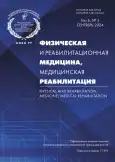Эффективность применения роботизированного комплекса Walkbot у пациентов с детским церебральным параличом
- Авторы: Нефедьева Д.Л.1,2, Абдрахманова Л.И.3,4, Бодрова Р.А.1
-
Учреждения:
- Российская медицинская академия непрерывного профессионального образования
- Филиал Казанского (Приволжского) федерального университета в городе Джизаке
- Казанский государственный медицинский университет
- Городская детская поликлиника № 7
- Выпуск: Том 6, № 3 (2024)
- Страницы: 253-262
- Раздел: ОРИГИНАЛЬНОЕ ИССЛЕДОВАНИЕ
- URL: https://journal-vniispk.ru/2658-6843/article/view/269352
- DOI: https://doi.org/10.36425/rehab631151
- ID: 269352
Цитировать
Полный текст
Аннотация
Обоснование. Актуальность исследования определяется необходимостью оценки эффективности роботизированной механотерапии в реабилитации детей с церебральным параличом.
Цель исследования ― оценить эффективность применения роботизированного комплекса Walkbot (Walkbot, Корея) у детей с детским церебральным параличом.
Материалы и методы. В исследование включено 35 пациентов с детским церебральным параличом, получавших курсы реабилитационной терапии на базе ГАУЗ «Городская детская поликлиника № 7». Проведён сравнительный анализ функциональных двигательных исходов заболевания у детей двух групп, в одной из которых проводилась локомоторная терапия на аппарате Walkbot, детям второй группы комплекс не назначался.
Результаты. Оценена эффективность применения роботизированного механотерапевтического комплекса Walkbot с учётом функциональных двигательных исходов у пациентов с детским церебральным параличом. В группе, где проводилась терапия, отмечена лучшая динамика уровня развития двигательных навыков по шкале GMFM-66 (на 6,8% у детей первой группы против 4,1% у детей второй группы, p=0,006). Определение индекса Хаузера (p=0,05) показало улучшение локомоторной функции, повысившей уровень независимости в повседневной жизни по шкале FIM (p=0,044), по сравнению с данными детей контрольной группы. Реализация эффекта прямо зависит от количества процедур и общего количества курсов реабилитации.
Заключение. Установлено, что дети с церебральным параличом, получившие комплекс роботизированной терапии на аппарате Walkbot, имеют лучшие двигательные исходы, касающиеся прежде всего локомоторной функции.
Ключевые слова
Полный текст
Открыть статью на сайте журналаОб авторах
Дарья Леонидовна Нефедьева
Российская медицинская академия непрерывного профессионального образования; Филиал Казанского (Приволжского) федерального университета в городе Джизаке
Автор, ответственный за переписку.
Email: DLNefedeva@mail.ru
ORCID iD: 0000-0002-0609-3178
SPIN-код: 8088-2744
кандидат медицинских наук, доцент
Россия, 125993, Москва, ул. Баррикадная, д. 2/1, стр. 1; Джизак, УзбекистанЛейсан Ильдусовна Абдрахманова
Казанский государственный медицинский университет; Городская детская поликлиника № 7
Email: Leisan.abdr@gmail.com
ORCID iD: 0009-0001-4176-4803
Россия, 420012, Казань, ул. Бутлерова, 49; 420103, Казань
Резеда Ахметовна Бодрова
Российская медицинская академия непрерывного профессионального образования
Email: Rezeda.Bodrova@tatar.ru
ORCID iD: 0000-0003-3540-0162
SPIN-код: 1201-5698
доктор медицинских наук, доцент
Россия, 123242 МоскваСписок литературы
- Физическая и реабилитационная медицина при детском параличе у детей. Национальное руководство. Часть 1 / под ред. Т.Т. Батышевой. Москва, 2021. 260 с.
- Клочкова О.А., Куренков А.Л. Ботулинотерапия при детском церебральном параличе. Москва: МЕДпресс-информ, 2020. 248 с.
- Семенова Е.В., Клочкова Е.В., Коршикова-Морозова А.Е., и др. Реабилитация детей с ДЦП: обзор современных подходов в помощь реабилитационным центрам. Москва: Лепта Книга, 2018. 584 с.
- Carlson H.L., Craig B.T., Hilderley A.J., et al. Structural and functional connectivity of motor circuits after perinatal stroke: A machine learning study // Neuroimage Clin. 2020. Т. 28. P. 102508. doi: 10.1016/j.nicl.2020.102508
- Johnston M.V. Plasticity in the developing brain: Implications for rehabilitation // Developmental Dis Res Rev. 2009. Vol. 15, N 2. P. 94–101. EDN: MMTPPV doi: 10.1002/ddrr.64
- Гуляева Н.В. Пластичность мозга и коннектопатии: механизмы коморбидности неврологических заболеваний и депрессии // Журнал неврологии и психиатрии. 2016. № 11. С. 157–162. EDN: XVOZBF doi: 10.17116/jnevro2016116111157-162
- Физическая и реабилитационная медицина при детском параличе у детей. Национальное руководство. Часть 2 / под ред. Т.Т. Батышевой. Москва, 2021. 308 с.
- Novak I., Morgan K. High-risk follow-up: Early intervention and rehabilitation // Handb Clin Neurol. 2019. Vol. 162. P. 484–510. EDN: XBSIJN doi: 10.1016/B978-0-444-64029-1.00023-0
- Войтенков В.Б., Скрипченко Н.В., Иванова М.В., и др. Роботизированная механотерапия у детей с двигательными нарушениями различного генеза // Гений ортопедии. 2014. № 2. С. 95–99. EDN: SGMPHL
- Даминов В.Д. Роботизированная механотерапия в нейрореабилитации // Вестник АГИУВ. Спецвыпуск. 2013. С. 83–88. EDN: WWBMGL
- Мосина М.О., Тихонов С.В., Селиванова Е.А., Батышева Т.Т. Экзоскелеты в комплексной реабилитации детей с нарушениями функции ходьбы // Детская и подростковая реабилитация. 2022. № 1. С. 27–38. EDN: DWFYZU
- Sveistrup H. Motor rehabilitation using virtual reality // J Neuro Engineering Rehab. 2004. Vol. 1, N 1. P. 10. doi: 10.1186/1743-0003-1-10
- Lee H.Y., Park J.H., Kim T.W. Comparisons between Locomat and Walkbot robotic gait training regarding balance and lower extremity function among nonambulatory chronic acquired brain injury survivors // Medicine. 2021. Vol. 100, N 18. P. e25125. doi: 10.1097/MD.0000000000025125
- Баранов А.А., Намазова-Баранова Л.С., Куренков А.П., и др. Комплексная оценка двигательных функций у пациентов с детским церебральным параличом. Учебно-методическое пособие. Москва: ПедиатрЪ, 2014. 84 с.
- Белова А.Н. Шкалы, тесты и опросники в неврологии и нейрохирургии. Москва, 2004. 432 с.
- Свидетельство о государственной регистрации программы для ЭВМ № 2010617487 от 1 декабря 2010. [Сведения обновлены 30.06.2021]. Режим доступа: https://reestr.digital.gov.ru/reestr/368878/. Дата обращения: 15.04.2024.
- Клинические рекомендации по реабилитации детей с детским церебральным параличом (ДЦП). Москва: Союз педиатров России, Всероссийское общество неврологов и др., 2017. 62 с.
- Cramer S.C., Sur M., Dobkin B.H., et al. Harnessing neuroplasticity for clinical applications // Brain. 2011. Vol. 34, № 6. P. 1591–1609. EDN: ONFNNL doi: 10.1093/brain/awr039
- Borggraefe I., Schaefer J.S., Klaiber M., et al. Robotic-assisted treadmill therapy improves walking and standing performance in children and adolescents with cerebral palsy // Eur J Paediatric Neurology. 2010. Vol. 14, N 6. P. 496–502. doi: 10.1016/j.ejpn.2010.01.002
- Carvalho I., Pinto S.M., Chagas D., et al. Robotic gait training for individuals with cerebral palsy: A systematic review and meta-analysis // Arch Physical Med Rehabilitat. 2017. Vol. 98, N 11. P. 2332–2344. doi: 10.1016/j.apmr.2017.06.018
- Lefmann S., Russo R., Hillier S. The effectiveness of robotic-assisted gait training for paediatric gait disorders: Systematic review // J NeuroEngineering Rehab. 2017. Vol. 14, N 1. P. 1. EDN: YWILFT doi: 10.1186/s12984-016-0214-x
- Hwang J., Shin Y., Park J., et al. Effects of Walkbot gait training on kinematics, kinetics, and clinical gait function in paraplegia and quadriplegia // NeuroRehab. 2018. Vol. 42, N 4. P. 481–489. doi: 10.3233/nre-172226
Дополнительные файлы








